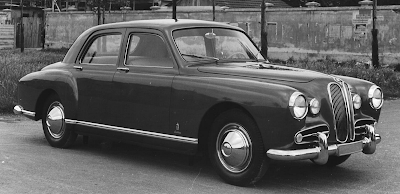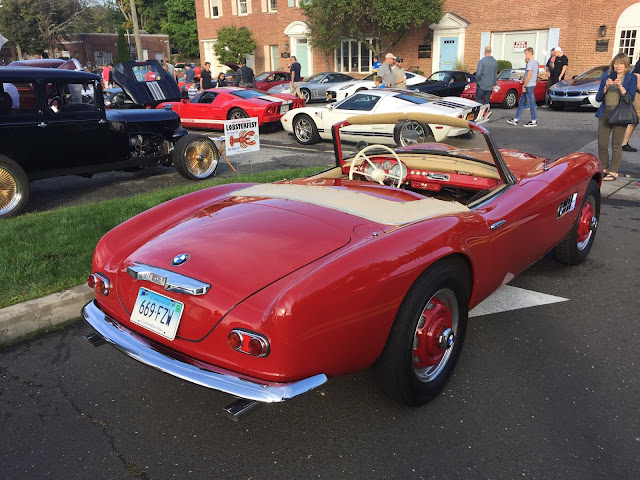BMW resumed building motorcycles in 1948, but didn't get around to resuming car production until late in 1952, over 7 years after World War II. Part of this was because the car factory at Eisenach was now in Soviet-controlled East Germany, where the new management would continue to build prewar designs labeled BMWs until 1951, when protests from BMW in Munich convinced them to change the name to EMW. BMW management was unsure of what to offer the public, and considered building old designs under license from Ford or Simca, reissuing versions of the pre-war BMW 327, or tooling up for the tidy little 331 prototype shown below.
The 331 resembled a much scaled-down version of the prewar 327, and had the advantage of a 600cc engine based upon a BMW motorcycle unit. It would have given BMW an entry in the small car market, like the Isetta 300* and 600 that eventually saved the company. Instead, BMW decided to contend with Mercedes for a share of the much smaller market for luxury sedans. After looking at a design from their in-house staff, BMW commissioned a prototype of the new 501 from Pinin Farina...
…but soon decided that this car too much resembled PF's work on the recently introduced Alfa Romeo 1900. So BMW returned to the design penned by Peter Schimanowski, which featured plump, swooping fenders and a glassy (for the era) cabin mounted on a new platform chassis with torsion bar suspension front and rear, independent at the front. Unusual engineering details included a 4-speed transmission mounted well back of the engine, adding foot room to the front cabin but giving a remote feel to the column shifter. Other intriguing details included a version of rack and pinion steering with a semicircular rather than linear rack. The M337 engine, however, was a version of the 1971cc inline six familiar from prewar BMWs, and also the source design for the Bristol which had been in production since 1947 in England, based upon BMW's drawings.
The new 501 appeared late in 1952 and was soon nicknamed the Baroque Angel for its chubby, somehow friendly-looking contours. Owing to small production capacity and an austere postwar economy, it took until September 1953 to build a thousand 501s, and bodies for the first couple of thousand cars were built by Baur, which also built special versions like cabriolets. Below is a 502...
That 502 designation signaled the arrival in spring 1954 of a new, aluminum-block overhead-valve V8. Designed by Alfred Boning (father of the 331 prototype) and initially sized at 2.6 liters, it went into the existing sedan bodies as well as coupes like the Autenreith-bodied version shown below.
BMW also considered offering a sports car to appeal to the type of customer who had bought their 328 in the Thirties, and who had supported engineer Ernst Loof's BMW-engined Veritas* specials the late Forties. Now Loof had returned to employment at BMW, and he sketched a two-seater based upon the new V8 engine in early 1954. The car echoed some of Loof's Veritas details, such as the grille and headlights, but the details were not tied together by any strong visual theme. When US distributer Max Hoffman* saw the car below, he recommended that BMW hire an ex-Loewy Associates industrial designer named Albrecht Goertz...
Goertz worked quickly, and proposed two different cars based on the new V8; they appeared at the Frankfurt Auto Show in fall of 1955. These turned out to be the 503, a 2 + 2 in coupe and cabriolet form on the 111.6" wheelbase of the 502, and the 507, a two-seater on a 98" wheelbase. A 503 cabriolet, one of 139 built from 1956 through 1959, is shown below.
Goertz had given the car the low, lean proportions of contemporary Italian designs, yet reinforced the BMW identity by retaining the traditional vertical twin-kidney grille. Under the hood of this understated car was a new 3.2 liter version of the V8, a feature shared like the torsion bar suspension with the 507. Another aspect of the design shared by few American cars save the '53 Loewy Studebaker coupes, was that wheels were positioned close to the car's flanks, which tucked inward towards the rocker panels. This, along with the full, radiused wheel arches, gave the wheels a leading role in the first impression.
The design was even more wheel-focused on the 507 above, where flanges formed into the forward wheel arches extend back into the doors and aft of the rear wheels to the tapered tail. The silver car also shows how well the Goertz-designed removable hardtop harmonized with the lines. If the 503 impressed show audiences with its careful proportions and restraint, the 507 just flat-out stunned them. There was nothing anywhere in BMW's previous offerings remotely like it. At the prow the twin grilles had been flattened to front the low hood line; a subtle air intake was formed into the hood, while a chromed vent aft of the front wheels offered the only area of bright metal trim beyond the bumpers, door and trunk handles...
The interior trim was in keeping with the car's GT theme, with integrated arm rests and map bins predictive of later Detroit luxury cars, and a distinctive x-pattern steering wheel. Few drivers actually sat behind that wheel, however, owing to the $9,000 price tag, which disappointed Max Hoffman by exceeding the price of the Mercedes 300SL coupes he also offered in his showrooms. Relying exclusively on hand labor to form the bodywork, BMW managed to sell only 413 of the 503 and around 255 of the lovely 507, including 3 chassis for custom coachwork* (who on earth needed that?) during 3+ years of production, which ended in 1960. The 507 was such a well-remembered design, though, that when decades later BMW decided to offer another V8 roadster in the form of the Z8, its exterior echoed the 507.
*Footnote: Ernst Loof's involvement with the postwar Veritas cars based originally on prewar BMWs is reviewed in "Veritas and BMW: Truth and Consequences", the post from October 6, 2019. Max Hoffman's contributions to the postwar sports car boom are reviewed in "Max Hoffman: An Eye for Cars" from May 1, 2016. Raymond Loewy"s design for his personal 507, which was at least interesting, was reviewd in "Lines of Influence Part 2: Avanti Antecedents", posted Feb. 18, 2016.
Photo Credits:
Top: wikimedia
2nd: Pinin Farina
3rd: Ludwig Wegmann on wikimedia
4th: wikimedia
5th: flickr.com
6th: coches.com
7th thru 9th: the author
10th thru 12th: Lt. Jonathan Asbury, USN












No comments:
Post a Comment